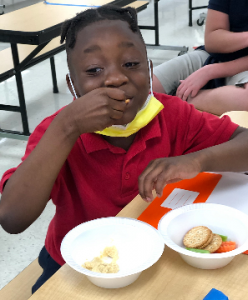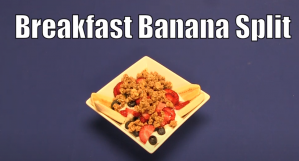Breakfast is the most important meal of the day but oftentimes breakfast is the meal that gets skipped the most. Eating a nutritious meal upon waking improves mental and physical performance throughout the day. Regularity in breakfast consumption has been linked with improvement in academic performance as well as cognition among children. Furthermore, breakfast consumption is considered an important determinant of a healthful lifestyle and its association with healthful behaviors may favorably influence body mass index (BMI).[1] Despite breakfast’s positive attributes, many children go to school without breakfast. Between 1965 and1991, breakfast consumption declined by 15% to 20%, resulting in as few as 64% of adolescents consuming breakfast.[2] So why are school-aged children skipping breakfast? Factors to consider include a morning rush to work, to school, a list of to-dos, errands, and so on, all of which result in breakfast being the meal skipped the most. School-aged children are impacted by the increased pressure and commitments by the adults in their lives and more than ever before, school-aged children have two working parents. Moreover, families have limited income, a lack of healthy food options at home, and oftentimes a misunderstanding of the importance of breakfast.[3]

So why are kids not eating breakfast?
Many complex reasons exist as to why school-aged children skip breakfast and an additional, simple reason to consider is that school-aged children do not enjoy healthy breakfast foods. Impressions and personal opinions on what constitutes breakfast food may also influence healthy breakfast choices. Alarmingly, many ready-made breakfast food items are deficient in nutrients, high on sugar, and do not adequately sustain youth energy until lunch. In addition, American adults are misled to believe these breakfast staples, such as sugary breakfast cereals or pastries, are well-suited for breakfast, whereas more nutritious food choices consumed at lunch or dinner, like sandwiches and lean proteins with brown rice, can be eaten as breakfast foods. These beliefs create barriers for pursuing a healthy diet overall. After learning that many foods became breakfast staples because of intensive marketing campaigns, and that people in other cultures readily include lunch or dinner foods on their breakfast plate, traditional beliefs about breakfast foods can be changed.[4] This change can lead to individuals including new foods to adopt a healthier breakfast diet. Outside of the American culture, other cultures readily consume foods considered lunch or dinner foods for breakfast. Traditional American beliefs that have become misconceptions about breakfast foods can be changed to encourage school-aged children and American adults to consume new and different breakfast foods to support a healthier breakfast diet and lifestyle.

What is 4-H doing to help breakdown breakfast barriers?
In 4-H, hands-on nutrition activities are used to facilitate discussion around breakfast foods and healthy food options. Understanding what makes food nutritious is a process broken down in a step-by-step approach. First, youth are given food nutrition labels to explore protein, fat, carbohydrates, calories, and other nutrition information. The objective of exploring nutrition labels is to create an awareness of what is being consumed while linking the information to consumer health. Next, youth view various marketing advertisements in magazines and choose a product within the advertisement. Additionally, youth measure the amount of sugar and fat in the food products to gain a visual understanding of the quantity of sugar and fat they are consuming. Woven throughout this activity, adults engage youth in discussion on healthy foods they would like to eat for breakfast and how to incorporate healthy food choices into their daily diets. Finally, 4-H adult mentors provide healthy recipes examples that are full of flavor and nutrition. 73% of 154 school-aged children “liked” the Food Hero[5] Breakfast Banana Split recipe, which includes non-fat yogurt, granola, bananas, and fresh berries and a simple combination of marinated chickpeas with fresh vegetables is a recipe adapted from the New Your Times Cooking recipe that incorporates healthy ingredients for a nutritious, lasting breakfast.[6]

To make a breakfast banana split, all you need is yogurt, granola, freshly washes blueberries, washed and sliced strawberries and one peeled banana. Slice the banana down the middle and place in a bowl or plate. Top with yogurt, strawberries, blueberries, and granola. You can even add a bit more sweetness with a drizzle of honey.[5]
Marinated chickpeas with fresh vegetables is an easy and sustaining a breakfast option as well. The chickpeas contain protein that help keep you fuller longer and you can toss everything together and refrigerate it overnight. It is nutritious, easy, and convenient for a busy morning breakfast. To make, add cooked chickpeas (in a can are quick and delicious), diced bell peppers, diced tomatoes, diced cucumbers, diced sweet onion, and chopped parsley into a bowl or container. Combine 3 tablespoons of extra virgin olive oil, 3 tablespoons of red wine vinegar, 2 minced garlic cloves, 1 teaspoon of salt, and ½ teaspoon of black better. Drizzle the oil mixture on top of the chickpeas and vegetables and let set overnight or eat immediately. To change it up, try new vegetables or add some crumbled feta cheese.[6]

Want some more ideas?
Here are a few other helpful ideas to get all the busy people in your family fueling up their bodies in the morning. For a quick and nutritious breakfast that can be eaten at home or on the way to school or work, make sure you include a fruit option, a dairy option, and a grain option.
- This could be a whole grain cereal, yogurt, and a diced apple.
- Or you could offer string cheese, blueberries, and whole grain crackers.
- Another choice could be a whole wheat pita with sliced strawberries and low-fat milk to drink. Spreading yogurt or hummus on the inside of the pita will help the strawberries stay in place and increase the nutritional value.
Don’t forget to try non-traditional breakfast foods such as an English muffin topped with marina, low-fat cheese and a favorite veggie or even two! To make this easier, look no farther than your leftovers from dinner or lunch.
- A bowl of quinoa or rice with chicken and vegetables will help you power through your morning.
- Or you could offer a baked potato topped with broccoli florets.
- Another option could be a bean burrito with a whole grain tortilla. Make sure to includee a dairy option like milk, cheese, or yogurt.
In sum, a healthy lifestyle is supported by consuming a healthy, complete breakfast. By changing misconceptions surrounding breakfast foods, families can start their day with nutritious, long-lasting foods to sustain them through until their next meal. Encouraging and supporting school-aged children to explore food items that are not pre-packaged and other non-traditional breakfast items are the foundation for a healthy future.
This blog was co-written by Noelle Guay & Kimber Sarver.
[1] Affenito SG. 2007. Breakfast: a missed opportunity. J Am Diet Assoc. 2007; 107:565–9.
[2] Mahoney, C. R., Taylor, H. A., Kanarek, R. B. and Samuel, P. 2005. Effect of Breakfast Composition on Cognitive Processes in Elementary School Children. Physiology & Behavior, 85(5), 635-645.
[3] Jackson L.W. 2013. The most important meal of the day: why children skip breakfast and what can be done about it. Pediatr Ann. 42: 184-187. 10.3928/00904481-20130823-10.
[4] Bian, L., & Markman, E. M. (2020a). What should we eat for breakfast? American and Chinese children’s prescriptive judgments about breakfast foods. Cognitive Development, 54, 100873. https://doi.org/10.1016/j.cogdev.2020.100873.
[5] Oregon State University Food Hero. 2021. Breakfast Banana Split. Retrieved from www.foodhero.org/recipes/breakfast-banana-split, 2021.
[6] Lopez-Alt, J.K. 2020. Marinated Chickpeas. Retrieved from https://cooking.nytimes.com/recipes/1021464-marinated-chickpeas.
 0
0
